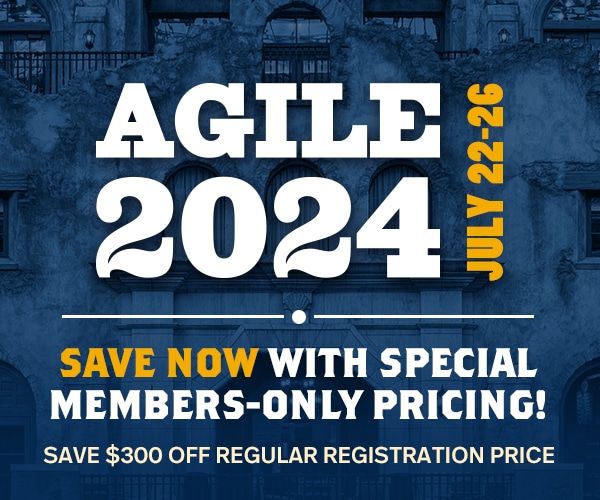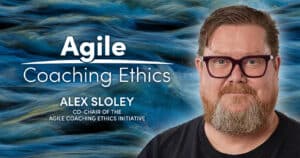PMI and Agile Alliance have joined forces to create an Agile Practice Guide with the intention of building a greater understanding of Agile practices, with emphasis on how Agile relates to the project management community. Although that is a very clear charter, it’s also very broad, likely leaving many people wondering, “What will they actually cover in this guide?” This blog post intends to offer a preview of what readers can expect to find in the Agile Practice Guide.
We describe the Agile Mindset
To set the right context, we begin by introducing the Agile Manifesto mindset, values, and principles. The opening also covers the concepts of definable and high-uncertainty work, and the correlation between Lean, Kanban methods, and Agile approaches.
We perform a deep analysis of Life Cycle Selection
For Project Managers, the most visible aspect of Agile approaches is arguably the delivery life cycle. Various life cycles are discussed in the guide, along with suitability filters, tailoring guidelines and common combinations of approaches. This topic is intended to show what is and is not Agile delivery, and to be more thoughtful for when it’s appropriate.
We give a few suggestions for Creating an Agile Environment
There are several critical factors to consider when creating an Agile Environment such as servant leadership and team composition. We explore those factors in depth.
We also offer recommendations for Delivering in an Agile Environment
It is our goal to help you learn how to organize your team and equip them with common practices for delivering value on a regular basis. We provide examples of empirical measurements for the team and for reporting status.
We then explore Organizational Considerations for Project Agility
Every project is influenced strongly by the context of the organization. This guide explores organizational factors that impact the use of Agile practices, such as culture, readiness, business practices, and the role of a PMO.
We close by issuing A Call to Action
The content listed here describes the substance of what our team pulled into the Guide. With such a broad field to cover, we did our best to find the most important concepts and techniques to help project practitioners shift to an Agile way of working. That being said, we knew from the beginning this guide would not be perfect. In that spirit, we close the main body of the guide with a call to action requesting your input for the continuous improvement of the practice guide.
The guide has a bit more to cover. Essential information that is too bulky and would disrupt the flow of the story is located in three annexes following the main text.
We outline a PMBOK® Guide Mapping
To help those formally trained in project management transition to an Agile mindset, we constructed a mapping of Agile concepts to the Project Management Process Groups and Knowledge Areas defined in the PMBOK® Guide, Sixth Edition. The mapping describes how hybrid and Agile approaches address the attributes described in the PMBOK® Guide Knowledge Areas. It covers what stays the same and what may be different along with some guidelines to consider for increasing the likelihood of success.
We also provide an Agile Manifesto Mapping
Conversely, it made sense to indicate where the four value statements of the Agile Manifesto and the twelve underlying principles are covered in the Agile Practice Guide.
We list an Overview of Agile and Lean Frameworks
In order to illustrate the many ways to be Agile, the guide describes some of the most commonly used Agile approaches, such as Scrum, eXtreme Programming (XP), Kanban, Scrumban, Feature-Driven Development (FDD), Dynamic Systems Development Method (DSDM), Agile Unified Process (AUP), Scrum of Scrums, Scaled Agile Framework, Large Scale Scrum, Enterprise Scrum and Disciplined Agile.
Further useful information that supplements the main body of the practice guide is captured in three appendices:
Appendix X1 – Contributors and Reviewers
This lists the people who have created and improved the practice guide.
Appendix X2 – Attributes that Influence Tailoring
This appendix provides high-level guidance on when and how to tailor Agile approaches. It can be used to determine circumstances that might warrant changing or introducing new techniques and then offers some recommendations to consider.
Appendix X3 – Agile Suitability Filter Tools
Proposes a model for assessing the suitability of Agile, hybrid, and predictive approaches. It is intended to help people find the sweet spot for their current initiative.
Concluding the document are references, a bibliography, and a glossary. The references section lists the standards and other formal foundational publications cited.
The bibliography is categorized by the practice guide section, indicating additional knowledge assets that provide detailed information on topics covered in this practice guide. Here you’ll find pointers to books, blogs, videos, graphics, and other useful guidance that you may wish to consider for further study.
The glossary is a list of terms and their definitions as used in this practice guide that are specific to the Agile mindset. Refer to the glossary whenever you’re unsure of how a term may be used.
What do you think?
We look forward to your views and insights. Please share them in the comments, and we’ll make sure they are considered in the list of improvements for future versions of the practice guide.











